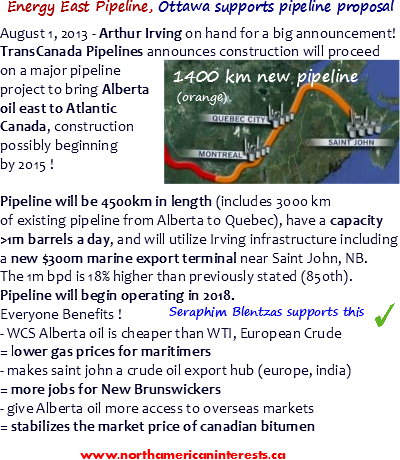Energy East Pipeline initial design/construction in 2015. operational by 2018.
August 1, 2013 the first major oil pipeline connecting Atlantic Canada to Alberta is closer to becoming a reality which is great news for Maritimers but especially the province of New Brunswick where the local economy is set to benefit the most.
The project has a cost of $12 billion but will pay dividends in Atlantic Canada where jobs will be created (50 full time at the new export terminal alone) and gas prices will be lowered (nearly 50% of oil is imported and that oil commands higher prices than Alberta west-canadian-select crude).
Advantages
Saint John is home to Canada's largest oil refinery (350th bpd) which could undergo expansion as a result of the increased throughput.
Imperial Oil (exxonmobil) recently announced that it will closing its 95 year old 70,000+ bpd refinery in Dartmouth, NS. The closure leaves Halifax Shipyards with a problem - propane and butane supply shortfall. If there were more pipelines in place the refinery in Dartmouth might not have been shut down (exit-year 2013).
Environmental Concerns
Environmentalists cite oil spills in 2009 as a reason to hault construction but I say not so fast ! Pipeline technology has come a long way since those older pipelines were constructed (some more than a decade old). Like the proposed Keystone XL Pipeline, the newest portion of the Energy East pipeline will be built to prevent leaks. Pipeline companies have developed new leak detection systems which makes use of both infrared equipment and acoustic sensors. After the Lac Megantic rail incident, Quebec may be more supportive of a new pipeline.
